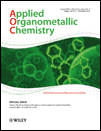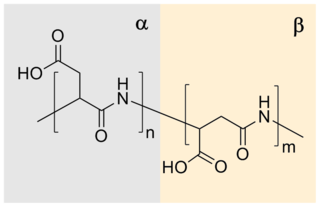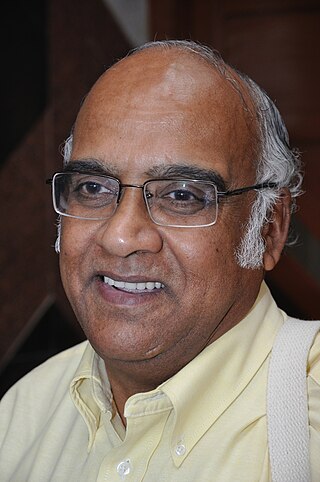
The National Chemical Laboratory (NCL) is an Indian government laboratory based in Pune, in western India.

Nature Materials is a monthly peer-reviewed scientific journal published by Nature Portfolio. It was launched in September 2002. Vincent Dusastre is the launching and current chief editor.
Curing is a chemical process employed in polymer chemistry and process engineering that produces the toughening or hardening of a polymer material by cross-linking of polymer chains. Even if it is strongly associated with the production of thermosetting polymers, the term "curing" can be used for all the processes where a solid product is obtained from a liquid solution, such as with PVC plastisols.

Advanced Functional Materials is a peer-reviewed scientific journal, published by Wiley-VCH. Established in February 2001, the journal began to publish monthly in 2002 and moved to 18/year in 2006, biweekly in 2008, and weekly in 2013.
Solution polymerization is a method of industrial polymerization. In this procedure, a monomer is dissolved in a non-reactive solvent that contains a catalyst or initiator.

Applied Organometallic Chemistry is a monthly peer-reviewed scientific journal published since 1987 by John Wiley & Sons. The editor-in-chief is Cornelis J. Elsevier.
X-Ray Spectrometry is a bimonthly peer-reviewed scientific journal established in 1972 and published by John Wiley & Sons. It covers the theory and application of X-ray spectrometry. The current editor-in-chiefs are Johan Boman and Liqiang Luo.

The Journal of Raman Spectroscopy is a monthly peer-reviewed scientific journal covering all aspects of Raman spectroscopy, including Higher Order Processes, and Brillouin and Rayleigh scattering. It was established in 1973 and is published by John Wiley & Sons. The editor-in-chief is Laurence A. Nafie.
Acta Crystallographica is a series of peer-reviewed scientific journals, with articles centred on crystallography, published by the International Union of Crystallography (IUCr). Originally established in 1948 as a single journal called Acta Crystallographica, there are now six independent Acta Crystallographica titles:

Willis Harmon Ray is an American chemical engineer, control theorist, applied mathematician, and a Vilas Research emeritus professor at the University of Wisconsin–Madison notable for being the 2000 winner of the prestigious Richard E. Bellman Control Heritage Award and the 2019 winner of the Neal Amundson Award.

Neal Russell Amundson was an American chemical engineer and applied mathematician. He was the chair of the department of chemical engineering at the University of Minnesota for over 25 years. Later, he was the Cullen Professor of Chemical & Biomolecular Engineering and Mathematics at the University of Houston. Amundson was considered one of the most prominent chemical engineering educators and researchers in the United States. The Chemical Engineering and Materials Science building at the University of Minnesota-Twin Cities bears his name.

Macromolecular Chemistry and Physics is a biweekly peer-reviewed scientific journal covering polymer science. It publishes full papers, talents, trends, and highlights in all areas of polymer science, from chemistry to physical chemistry, physics, and materials science.

Macromolecular Bioscience is a monthly peer-reviewed scientific journal covering polymer science. It publishes Reviews, Feature Articles, Communications, and Full Papers at the intersection of polymer and materials sciences with life science and medicine. The editorial office is in Weinheim, Germany. The editor-in-chief is Anne Pfisterer. According to the Journal Citation Reports, the journal has a 2020 impact factor of 4.979.

Ullmann's Encyclopedia of Industrial Chemistry is a major reference work related to industrial chemistry by Chemist Fritz Ullmann, first published in 1914, and exclusively in German as "Enzyklopädie der Technischen Chemie" until 1984.

Polyaspartic acid (PASA) is a biodegradable, water-soluble condensation polymer based on the amino acid aspartic acid. It is a biodegradable replacement for water softeners and related applications. PASA can be chemically crosslinked with a wide variety of methods to yield PASA hydrogels. The resulting hydrogels are pH-sensitive such that under acidic conditions, they shrink, while the swelling capacity increases under alkaline conditions.
Klaus-Dieter Hungenberg is a German chemist and professor at the University of Paderborn. Hungenberg has contributed to the field of reaction kinetics for polymerization processes, and has been honored with Professorship for his contributions in the field of reaction chemistry at the Institute for Polymer Material and Process (PMP), University of Paderborn.

Automated synthesis or automatic synthesis is a set of techniques that use robotic equipment to perform chemical synthesis in an automated way. Automating processes allows for higher efficiency and product quality although automation technology can be cost-prohibitive and there are concerns regarding overdependence and job displacement. Chemical processes were automated throughout the 19th and 20th centuries, with major developments happening in the previous thirty years, as technology advanced. Tasks that are performed may include: synthesis in variety of different conditions, sample preparation, purification, and extractions. Applications of automated synthesis are found on research and industrial scales in a wide variety of fields including polymers, personal care, and radiosynthesis.

Swaminathan Sivaram is an Indian polymer chemist, inventor, institution builder and a former director of the National Chemical Laboratory, Pune. He is known for his pioneering work on alkylation of tertiary alkyl halides with trialkylaluminum and olefin polymerization and holds the highest number of US patents by an Indian working outside the US. He is a fellow of several significant professional organizations. The Government of India awarded him the fourth highest civilian honour of the Padma Shri, in 2006, for his contributions to Indian science.

Subramaniam Ramakrishnan is an Indian polymer chemist, a professor at the Department of Inorganic and Physical Chemistry http://ipc.iisc.ac.in/~rk/and the designer at Macromolecular Design and Synthesis Group of Indian Institute of Science. He is known for his studies on design and synthesis of controlled polymer structures and is an elected fellow of the Indian Academy of Sciences The Council of Scientific and Industrial Research, the apex agency of the Government of India for scientific research, awarded him the Shanti Swarup Bhatnagar Prize for Science and Technology, one of the highest Indian science awards, in 2005, for his contributions to chemical sciences.
Greg N. Stephanopoulos is an American chemical engineer and the Willard Henry Dow Professor in the department of chemical engineering at the Massachusetts Institute of Technology. He has worked at MIT, Caltech, and the University of Minnesota in the areas of biotechnology, bioinformatics, and metabolic engineering especially in the areas of bioprocessing for biochemical and biofuel production. Stephanopoulos is the author of over 400 scientific publications with more than 35,000 citations as of April 2018. In addition, Greg has supervised more than 70 graduate students and 50 post-docs whose research has led to more than 50 patents. He was elected a fellow of the American Association for the Advancement of Science (2005), a member of the National Academy of Engineering (2003), and received the ENI Prize on Renewable Energy 2011.














